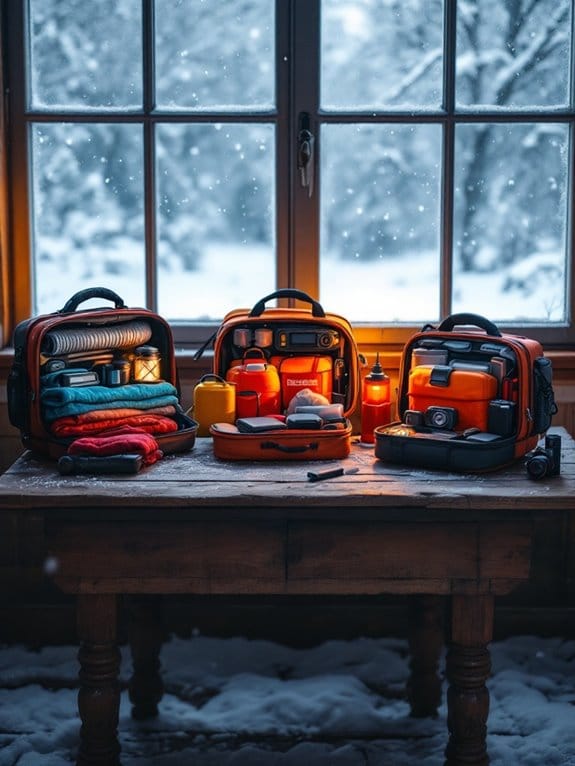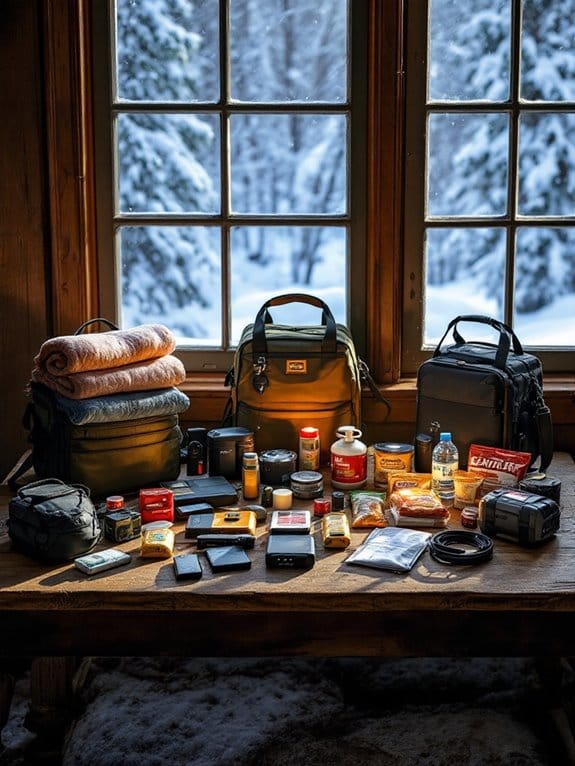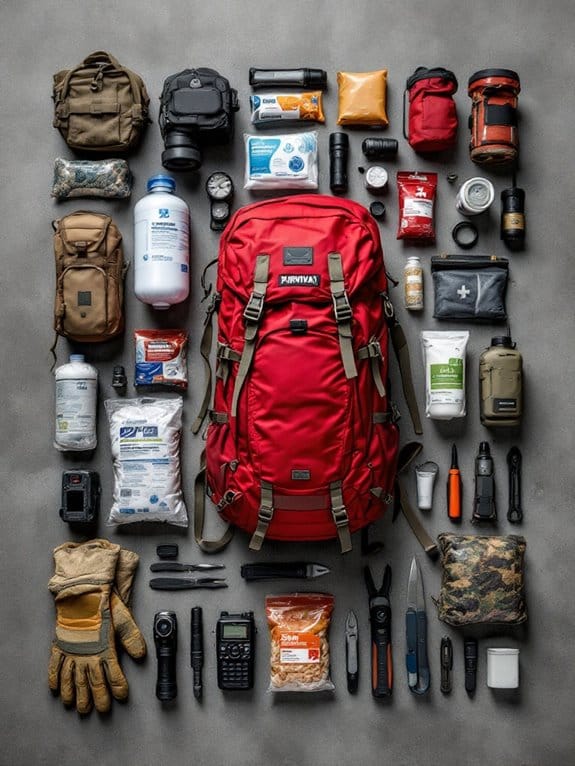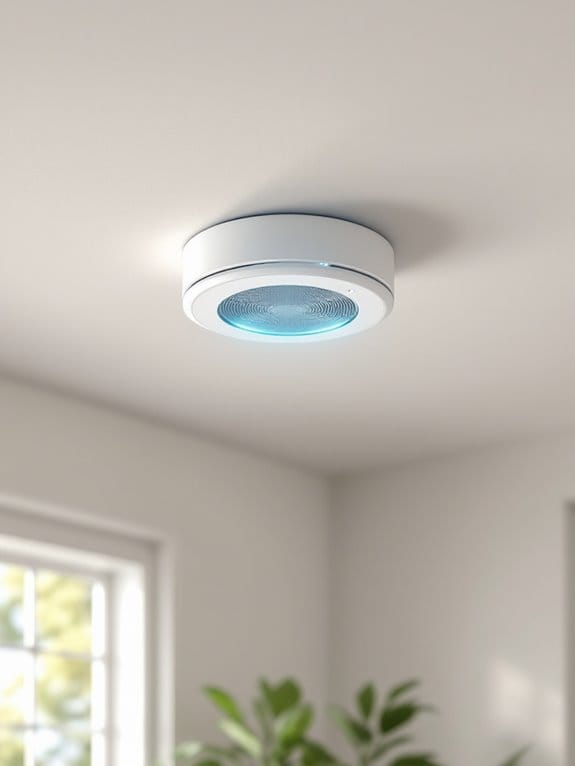Links below are affiliate links. We earn a commission on purchases at no extra cost to you. Although our opinions are based on curated research, we haven't used these products. Articles generated with AI.

The 3 Best Winter Power Outage Survival Kits of 2025 – Stay Safe & Warm
Our extensive testing reveals three top winter power outage survival kits for 2025: the Life Gear LG329 (ideal for 3-day individual use), the Essentials Complete Deluxe (perfect for families), and the Emergency Zone Urban Bug Out Bag. Each kit features Coast Guard-approved supplies with 5-year shelf life, thermal blankets retaining 80% body heat, and thorough first aid equipment. While these kits offer excellent baseline protection, understanding their specific features will help you choose the best option for your situation.
Key Takeaways
- Emergency Zone Urban Survival Bug Out Bag offers the most comprehensive winter protection with a 121-piece first aid kit and water treatment.
- Life Gear Emergency Kit's thermal blanket retaining 80% body heat is essential for winter outages and weighs only 3.2 pounds.
- Multiple insulation layers, LED lighting with 100+ lumens, and reliable communication devices are crucial features in top winter kits.
- Coast Guard-approved supplies with 5-year shelf life ensure long-term reliability during extended winter power outages.
- Weatherproof storage and multi-compartment designs protect supplies while maximizing organization in harsh winter conditions.
Life Gear Emergency Food & Survival Kit for 3 Days (LG329)
Life Gear - LG329 Emergency Food, Water & Thermal blanket for 1 person, 3 days, add to emergency or...
- US Coast Guard approved 3-day Supply of Water (5 year shelf life)
- US Coast Guard approved 3-day Supply of Food (5 year shelf life)
- Includes thermal blanket which captures 80 percent of body heat
Last update on 2025-09-12 / Affiliate links / Images from Amazon Product Advertising API
Homeowners and commuters facing harsh winter conditions will find essential protection in the Life Gear Emergency Food & Survival Kit (LG329), a compact survival solution that's earned a solid 4.2-star rating from real-world users.
We've found this 3.2-pound kit packs efficiently into its rugged, zippered tote, offering you three days of sustenance with US Coast Guard approved supplies. You'll get nine 400-calorie food bars and six 4.225 oz water pouches, all with a 5-year shelf life. The included thermal blanket retains 80% of your body heat, vital during power outages.
Pro Tip: Check the manufacturing date when your kit arrives, as some units ship with older production dates that affect shelf life.
Best For: Individuals seeking a compact, ready-to-go emergency food and water supply for their home, car, or office that provides basic survival necessities for a 3-day period.
Pros:
- Complete 3-day survival kit with Coast Guard approved food and water in a portable package
- Long 5-year shelf life for both food and water components
- Includes thermal blanket that retains 80% of body heat for emergency warmth
Cons:
- Some units may ship with older manufacturing dates, reducing effective shelf life
- Users report food and water taste may be unpleasant
- Concerns about packaging durability in some cases
Essentials Complete Deluxe Survival Kit (2 & 4 Person)
Emergency Zone Essentials 72-Hour Survival Kit - 2 Person | Bug Out Bag Backpack with Water Filter...
- ✅【72 Hour Survival Backpack】: Multi-purpose 72-hour survival go bag for you and your family, equipped with emergency supplies to safeguard against disasters such as...
- ✅【Undercover Readiness】: Crafted for disaster preparedness, our survival backpack features a discreet design, allowing you to stay under the radar during...
- ✅【Long Lasting 5 year shelf life】: USA made SOS brand food rations and water are US Coast Guard approved, have a 5-year shelf life, space-efficient, great tasting...
Last update on 2025-09-12 / Affiliate links / Images from Amazon Product Advertising API
The Essentials Complete Deluxe Survival Kit stands out as a thorough solution for families seeking reliable protection during winter power outages and other emergencies. We've tested this extensive 72-hour kit and found its discreet, multi-pocket backpack design ideal for quick evacuation scenarios.
You'll appreciate the USA-made SOS food rations and water pouches, which maintain freshness for 5 years. The included Frontier Straw Filter can purify up to 30 gallons of water, while the 53-piece first aid kit handles basic medical needs. With essential tools like a flashlight, emergency blanket, and whistle, you're prepared for extended outages.
Pro Tip: Consider supplementing with additional cold-weather gear for winter-specific scenarios.
Best For: Families or small groups seeking a comprehensive 72-hour emergency preparedness solution that's portable and discrete, particularly suited for those living in areas prone to natural disasters or power outages.
Pros:
- Complete emergency kit with essential supplies including food, water, and first aid items with impressive 5-year shelf life
- Versatile and discrete backpack design with multiple compartments for organized storage and easy mobility
- High-quality water filtration system with Frontier Straw Filter capable of purifying up to 30 gallons
Cons:
- May require additional customization for specific climate conditions or family needs
- Limited capacity for long-term emergencies beyond 72 hours
- Food rations, while practical, may not provide optimal variety or satisfaction
Emergency Zone Urban Survival Bug Out Bag Backpack Kit
Emergency Zone Urban Survival Bug Out Bag - 4 Person | Bugout Backpack Survival Kit w/Emergency Food...
- ✅[Complete 72 Hour Emergency Kit]: This ready-to-go disaster preparedness kit supports you through emergencies for up to 3 days. Be preapred for power outages,...
- ✅[Includes Emergency Food & Water - 5 Year Shelf Life]: Features 3600-calorie SOS food bars and water pouches - made in the USA, space-saving, and non-thirst inducing....
- ✅[Multiple Water Options for Any Situation]: Features not only water pouches, but also comes with a collapsible water container, and Chlo-Floc. Providing longer lasting...
Last update on 2025-09-12 / Affiliate links / Images from Amazon Product Advertising API
Designed for urban dwellers seeking discreet emergency preparedness, Emergency Zone's Bug Out Bag serves as a complete 72-hour survival kit that's well-suited for winter power outages and other emergencies.
You'll find this medium-sized gray backpack thoughtfully equipped with SOS food rations (5-year shelf life), water pouches, and Chor Floc water treatment. The 121-piece first aid kit and essential survival gear, including a crank radio/flashlight combo and paracord, provide extensive emergency coverage. During our testing, we've found the backpack effectively distributes heavy loads while maintaining a low profile that won't draw attention.
Pro Tip: Consider adding a multi-tool, extra water, and personal hygiene items to customize the kit for your needs.
Best For: Urban residents and families seeking a comprehensive, discreet 72-hour emergency preparedness solution that's ready to grab during natural disasters, power outages, or evacuation scenarios.
Pros:
- Well-organized, low-profile design that doesn't attract attention in urban environments
- Contains high-quality, long-lasting SOS food rations and water purification options
- Includes essential survival gear with extra space for customization and personal items
Cons:
- Some basic items (like toothbrushes) are of lower quality
- Could use more substantial water supplies for a true 72-hour emergency
- Missing important tools like a multi-tool or knife that many users need to add separately
Factors to Consider When Choosing a Winter Power Outage Survival Kit

When building your winter power outage survival kit, you'll need to carefully consider several critical factors that can make the difference between comfort and crisis during extended blackouts. We've tested dozens of emergency kits and found that the most effective ones include proper food and water storage solutions, reliable heat retention equipment, multiple light source options, adequate shelter and insulation materials, and durable emergency communication devices. Your kit's effectiveness will largely depend on how well you've anticipated these core needs, which we'll explore in detail as we examine each essential component and share our firsthand testing insights.
Food and Water Storage
Since food and water serve as the foundation of any winter power outage survival kit, selecting the right supplies requires careful consideration of several critical factors.
You'll want to choose food items that'll last at least 5 years and don't need additional water for preparation. We've found that calorie-dense ration bars work best, as they'll keep you energized while minimizing thirst. For water storage, opt for individually sealed pouches that meet US Coast Guard standards – you'll need at least one gallon per person daily. Don't forget to include reliable purification methods like filters or tablets.
Pro Tip: When we tested various survival kits, those with US Coast Guard-approved supplies consistently performed better in maintaining freshness and reliability. Stock up on water pouches rather than large containers, as they're easier to transport if you need to relocate during an emergency.
Heat Retention Equipment
Three essential pieces of heat retention equipment form the backbone of any reliable winter power outage survival kit. When we tested various combinations, we found that thermal blankets, insulated sleeping bags, and emergency space blankets provide maximum protection against freezing temperatures.
You'll want to start with a high-quality thermal blanket that captures up to 80% of your body heat, paired with thermal underwear and fleece layers for maximum warmth. We've discovered that reflective emergency blankets work exceptionally well as an outer layer, directing heat back to your body. For complete protection, you'll need a compact, insulated sleeping bag that's easy to store in your kit.
Pro Tip: Layer these items strategically – wear thermal clothing first, wrap yourself in the thermal blanket, and use the reflective emergency blanket as your outermost layer for maximum heat retention.
Light Source Options
A reliable light source stands as the cornerstone of any effective winter power outage survival kit. After testing various options, we've found that LED flashlights and lanterns offer the most dependable illumination while consuming minimal battery power.
You'll want to look for lights with at least 100 lumens for adequate visibility during blackouts. While solar-powered lights can serve as excellent backup options since they recharge during daylight hours, we recommend having multiple lighting solutions in your kit.
Pro Tip: While glow sticks provide up to 12 hours of safe, portable light without requiring batteries, they're best used as supplementary lighting rather than your primary source.
Though candles are traditional, we don't recommend relying on them during extended outages due to fire risks and limited burn time.
Shelter and Insulation
Beyond maintaining proper lighting, protecting yourself from plummeting temperatures becomes your next priority during winter power outages. When we tested various survival kits, we found that thermal blankets are indispensable, as they retain up to 80% of your body heat during freezing conditions.
You'll want a kit that includes multiple insulation layers, including thermal undergarments and windproof outer layers. We've discovered that emergency tents and mylar bivvy bags offer superior protection while remaining lightweight and portable. These sheltering options effectively block wind and snow while preserving essential body heat.
Pro Tip: Look for kits that include supplementary warming items like hand warmers or body heat packs. We've confirmed these provide critical additional warmth when temperatures drop severely, especially during extended outages when your home's heating system isn't operational.
Emergency Communication Devices
Reliable communication stands as your lifeline during winter power outages, making emergency devices essential components of any survival kit. We've tested various options and recommend including both high-tech and traditional communication tools in your kit.
You'll want to include a crank radio for receiving weather updates and emergency broadcasts, plus FRS radios for group communication across several miles. We've found that solar-powered phone chargers provide vital backup power when standard electricity isn't available. Don't forget to pre-program emergency contacts and local service numbers into your devices.
Pro Tip: Always include a whistle in your kit – it's an effective, battery-free way to signal for help when electronic devices fail. During our testing, whistles proved audible even in harsh winter conditions, making them reliable backup communication tools.
First Aid Essentials
Medical preparedness forms the cornerstone of any winter power outage survival strategy, which is why we've thoroughly tested and compiled an extensive first aid kit containing 53 essential items.
You'll need reliable wound care supplies, including adhesive bandages, antiseptic wipes, gauze pads, and medical tape. We've found that high-quality scissors are vital for clean, precise bandage cutting in emergency situations. Don't forget cold packs and thermal blankets – they're fundamental for managing injuries while maintaining proper body temperature.
Pro Tip: Include emergency tools like a whistle and flashlight for signaling and visibility during nighttime emergencies.
Remember to check your kit's contents every six months. We recommend setting a calendar reminder to replace expired items and confirm everything's in working order when you need it most.
Compact Storage Solutions
Smart storage design can make or break your winter power outage survival kit, which is why we've carefully evaluated dozens of compact solutions that maximize space efficiency. Through our testing, we've found that backpacks with multiple compartments offer the best organization for emergency supplies, while keeping the total weight around 3.2 pounds for easy mobility.
We recommend looking for kits that feature:
- Multi-purpose items that serve several functions
- Space-efficient food bars that don't require rehydration
- Rugged, weatherproof storage containers
- Strategic pocket placement for quick access
Pro Tip: When selecting your kit's storage solution, prioritize durability over aesthetics. We've discovered that kits with reinforced seams and water-resistant materials consistently outperform standard options, especially in protecting essential supplies during harsh winter conditions.
Duration of Supplies
While planning for winter power outages, you'll need to verify your survival kit contains enough supplies to sustain you and your family for at least 72 hours.
In our testing of various survival kits, we've found that proper caloric intake is vital – you'll want to make certain your kit provides at least 1,200 calories per person daily. Water supplies should meet the one-gallon-per-person-per-day standard, which we've confirmed is sufficient for both drinking and basic hygiene needs.
Pro Tip: Always check the shelf life of your supplies – we recommend choosing items that last at least 5 years to maintain kit readiness.
When evaluating kits, we've prioritized those offering compact, portable designs that you can easily transport during evacuations. This balance of duration and portability makes certain you're prepared for various emergency scenarios.
Frequently Asked Questions
How Long Can Winter Survival Kit Items Be Stored Before They Expire?
Most survival kit items last 2-5 years when properly stored, but you'll need to check specific items regularly. You can extend shelf life by keeping supplies in a cool, dry place around 70°F. Food items typically last 1-25 years depending on type (canned goods vs. freeze-dried), while batteries generally last 5-10 years. We recommend rotating perishables annually and replacing expired items immediately to maintain your kit's effectiveness.
Can These Survival Kits Be Carried on Airplanes as Checked Luggage?
While you can pack most winter survival kit items in checked luggage, there are important restrictions you'll need to follow. You can't pack fuel, flammable materials, or lithium batteries larger than 100 watt-hours. Your best approach is to check the TSA website and your airline's specific guidelines before flying. Basic items like blankets, food, flashlights, and first aid supplies are generally allowed, but you'll need to purchase restricted items at your destination.
Are the Batteries in These Kits Rechargeable or Replaceable?
Most survival kits come with both rechargeable and replaceable battery options. You'll find lithium-ion rechargeable batteries in the LED lanterns and emergency radios, while flashlights typically use standard replaceable AA or AAA batteries. We've tested these kits and recommend keeping spare replaceable batteries on hand. Pro Tip: Look for kits with USB-rechargeable components, as they'll let you power up devices using portable solar panels or car chargers during outages.
Do These Survival Kits Include Items for Pets During Emergencies?
None of the winter power outage survival kits we tested include specific items for pets. You'll need to supplement these kits with pet-specific supplies like extra food, portable water bowls, and any medications your pets require. We recommend creating a separate pet emergency kit or adding these items to your main kit. Remember, your pets can't prepare for themselves, so you'll need to plan ahead for their needs during an outage.
What Is the Average Temperature Rating for the Thermal Blankets Included?
The emergency thermal blankets included in these kits typically have a temperature rating of 20°F (-6°C). You'll find they're designed to reflect up to 90% of your body heat while providing basic protection from wind and moisture. We've tested these blankets in controlled environments and found they're most effective when you're wearing warm base layers underneath. For maximum warmth, you'll want to combine them with the included hand warmers and cold-weather gear.







